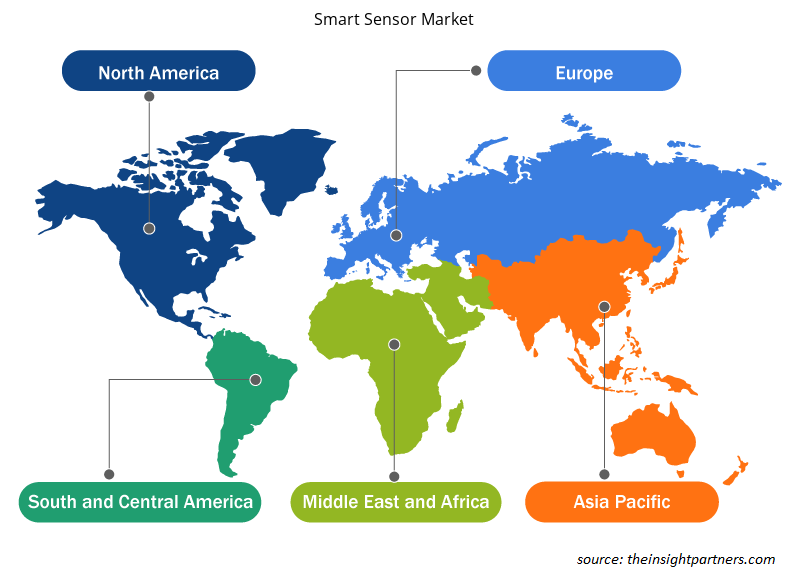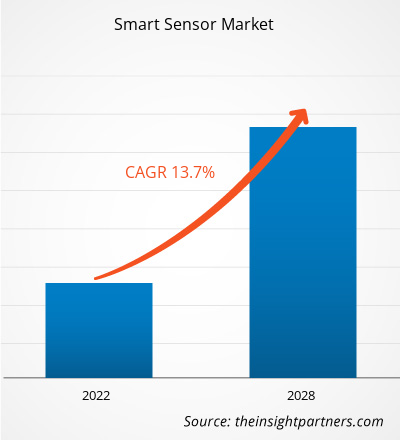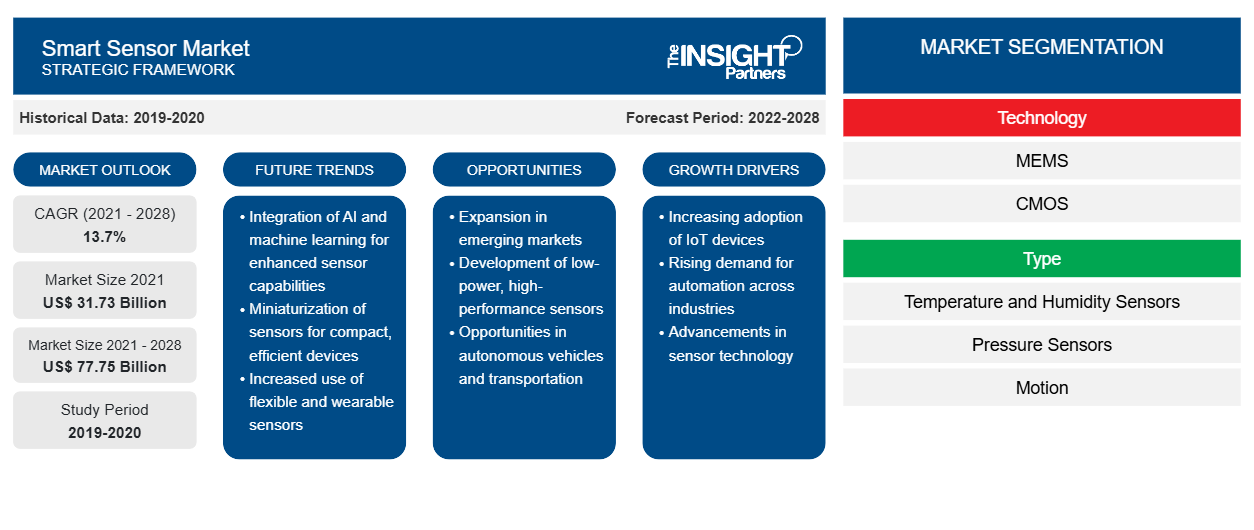من المتوقع أن ينمو سوق أجهزة الاستشعار الذكية من 31,731.1 مليون دولار أمريكي في عام 2021 إلى 77,747.6 مليون دولار أمريكي بحلول عام 2028. ومن المتوقع أن ينمو بمعدل نمو سنوي مركب قدره 13.7٪ بين عامي 2021 و 2028.
يُعد المستشعر الذكي أسرع وأكثر دقة من المستشعرات التقليدية. كما أن هذه المستشعرات أصغر حجمًا وتستهلك طاقة أقل من المستشعرات التقليدية. وقد اجتذب استخدام تقنية المستشعرات الذكية في الأجهزة القائمة على إنترنت الأشياء والإلكترونيات الاستهلاكية وتطبيقها في صناعات الطيران والدفاع والسيارات والطب الحيوي والرعاية الصحية والأتمتة الصناعية وأتمتة المباني والإلكترونيات الاستهلاكية والتعليم والروبوتات والزراعة والنقل الكثير من الاهتمام في السنوات القليلة الماضية. إن الزيادة في استخدام المستشعرات الذكية عبر التطبيقات هي عامل رئيسي في تعزيز حجم سوق المستشعرات الذكية .
مع تزايد المخاوف المتعلقة بالسلامة والأمن، يتزايد الطلب على أجهزة الاستشعار الذكية في الإلكترونيات الاستهلاكية، مما يؤثر على سوق أجهزة الاستشعار الذكية. تُستخدم أجهزة استشعار مختلفة، مثل أجهزة استشعار الأشعة تحت الحمراء للرؤية الليلية وأجهزة استشعار الصوت أو الميكروفونات والمراحيض الذكية، في أتمتة المنزل. تدمج الشركات ميزات مختلفة، مثل التنظيف التلقائي والتدفق التلقائي ومراقبة تسرب الخزان وحماية فيضان المياه ومراقبة الصحة، في أجهزة الاستشعار الذكية الخاصة بها. يمكن التحكم في الأضواء والمراوح بنظام أوتوماتيكي يستخدم أجهزة استشعار الأشعة تحت الحمراء أو الحركة.
علاوة على ذلك، مع نمط الحياة المتغير ومستوى المعيشة الحديث الجديد، يشهد الطلب على المطابخ المعيارية المتكاملة مع الأتمتة المنزلية نموًا هائلاً، مما يؤثر بشكل إيجابي على سوق أجهزة الاستشعار الذكية. يطور المصنعون أجهزة تعتمد على مستشعرات اصطناعية لمراقبة الاهتزاز وأصوات المطبخ والضوء والغاز ودرجة الحرارة والحرارة ودرجة الحرارة الكهرومغناطيسية والضوضاء، مما يزيد من حجم سوق أجهزة الاستشعار الذكية. على سبيل المثال، تقدم شركة Analog Devices, Inc. أجهزة استشعار pHEMT من نوع HMC1126 GaAs. وهو مكبر منخفض الضوضاء يعمل في نطاق 400 ميجا هرتز - 52 جيجا هرتز ويُستخدم في العديد من التطبيقات، مثل أجهزة الراديو الميكروويف ومحطات الفتحة الصغيرة جدًا (VSATs) ومعدات الاختبار واتصالات الجيل الخامس.
قم بتخصيص هذا التقرير ليناسب متطلباتك
ستحصل على تخصيص لأي تقرير - مجانًا - بما في ذلك أجزاء من هذا التقرير، أو تحليل على مستوى الدولة، وحزمة بيانات Excel، بالإضافة إلى الاستفادة من العروض والخصومات الرائعة للشركات الناشئة والجامعات
- احصل على أهم اتجاهات السوق الرئيسية لهذا التقرير.ستتضمن هذه العينة المجانية تحليلاً للبيانات، بدءًا من اتجاهات السوق وحتى التقديرات والتوقعات.
أدت تقنية المستشعرات الذكية إلى تقدم تكنولوجي سريع في الهواتف الذكية والأجهزة القابلة للارتداء. ويطالب مصنعو السيارات بشكل متزايد بأجهزة استشعار ذكية لتحسين السلامة والراحة. وأصبح استخدام التكنولوجيا اللاسلكية لمراقبة والتحكم في أجهزة الأمان المزودة بأجهزة استشعار ذكية أكثر شيوعًا. وفي ظل جائحة كوفيد-19، فإن الارتفاع في الطلب على الأجهزة القابلة للارتداء المزودة بأجهزة استشعار ذكية، والدعم الحكومي المستمر لبناء المباني الخضراء، والصيانة التنبؤية، توفر فرصًا مربحة للاعبين في سوق أجهزة الاستشعار الذكية.
لقد أدى ارتفاع معدل انتشار الهواتف الذكية إلى تغذية نمو سوق أجهزة الاستشعار الذكية بشكل كبير. تشمل أجهزة الاستشعار الذكية أجهزة استشعار شائعة، مثل الحركة والموقع والضوء المحيط ومقياس التسارع والجيروسكوب . تعمل أجهزة استشعار معدل الامتصاص النوعي (SAR) على تعزيز الاتصال لمجموعة واسعة من التقنيات اللاسلكية، مثل 5G sub-6/4G/Wi-Fi في الهواتف الذكية والأجهزة اللوحية وأجهزة الكمبيوتر المحمولة. تقدم SEMTECH، وهي شركة رائدة في توريد أشباه الموصلات، أجهزة استشعار PerSeTM Connect وPerSe Connect Pro وPerSe Control، والتي يمكن استخدامها في تطبيقات مختلفة، مثل الهواتف الذكية وأجهزة الكمبيوتر المحمولة والأجهزة اللوحية والأجهزة القابلة للارتداء.
تعمل العديد من الشركات على تطوير أجهزة استشعار ذكية جديدة ومتقدمة تجمع بين وحدات التحكم الدقيقة في حزمة واحدة. تتيح التقنيات الحديثة، مثل الذكاء الاصطناعي وإنترنت الأشياء، هذا المزيج داخل عبوات صغيرة. على سبيل المثال، يمكن لجهاز BHA250 من Bosch Sensortec الجمع بين وحدة تحكم دقيقة 32 بت ومستشعر تسارع 14 بت في حزمة 2.2 × 2.2 × 0.95 مم3. علاوة على ذلك، قامت شركة TE Connectivity بدمج أجهزة الاستشعار مع الموصلات لتعبئة الوظائف في مساحة صغيرة. تؤثر هذه التطورات في تكنولوجيا أجهزة الاستشعار الذكية بشكل إيجابي على نمو سوق أجهزة الاستشعار الذكية. مع النمو في صناعة الإلكترونيات الاستهلاكية، مثل آلات بيع المشروبات الذكية، وأنظمة أتمتة المنزل الذكي، وأجهزة الكمبيوتر البسيطة، والمساعدين الرقميين (مثل أليكسا)، والأجهزة القابلة للارتداء البشرية، زاد الطلب على أجهزة الاستشعار الذكية في سوق أجهزة الاستشعار الذكية. تستمر المنتجات الاستهلاكية التقليدية، مثل أجهزة الكمبيوتر المحمولة والهواتف الذكية وأجهزة التلفزيون، في تجاوز التوقعات مع استمرار المستهلكين في تبني منتجات جديدة وناشئة، بما في ذلك الأجهزة القابلة للارتداء ومكبرات الصوت الذكية التي يتم تنشيطها صوتيًا وأجهزة المنزل الذكية.
وفقًا لدراسات متعددة، ستتصل عشرات المليارات من أجهزة إنترنت الأشياء بالإنترنت في السنوات القادمة، مما سيؤثر بشكل كبير على سوق أجهزة الاستشعار الذكية. يدفع كوفيد-19 أجندات المرونة الحضرية واستراتيجيات التحول الرقمي مع تكيف حكومات المدن مع واقع جديد.
تأثير جائحة كوفيد-19 على سوق أجهزة الاستشعار الذكية
لقد أدى ظهور فيروس كورونا المستجد إلى تسليط الضوء على الحاجة إلى تسخير البنية الأساسية الرقمية لمراقبة المرضى عن بعد. ونظرًا للتطور البطيء للاختبارات واللقاحات الفيروسية الحالية، فقد تم تحديد الحاجة الأكبر إلى الكشف عن المرض بشكل أكثر قوة ومراقبة صحة الفرد والسكان، وهو ما يمكن أن تساعد فيه أجهزة الاستشعار القابلة للارتداء. وفي حين تم استخدام فائدة هذه التكنولوجيا لربط المقاييس الفسيولوجية بالحياة اليومية والأداء البشري، فمن الضروري تطبيقها للتنبؤ بحدوث فيروس كورونا المستجد.
إن الطلب المتزايد على الأجهزة الموفرة للطاقة يدفع الطلب على أجهزة الاستشعار الذكية في سوق أجهزة الاستشعار الذكية في أمريكا الشمالية. وتتجه الشركات نحو معدات موفرة للطاقة، حيث يتطلب السيناريو المتغير معدات ومنتجات موفرة للطاقة. وعلاوة على ذلك، زاد الطلب على أجهزة الاستشعار في سوق أجهزة الاستشعار الذكية عبر مجموعة متنوعة من الصناعات مع رفع القيود الصارمة التي تفرضها الحكومات، والتي تكتسب زخمًا في صناعات الأتمتة. بالإضافة إلى ذلك، فإن الطلب على أجهزة الاستشعار في قطاع السيارات مدفوع بالرغبة في تقليل الوزن المتوسط للسيارة. تساعد السيارات خفيفة الوزن في كل من كفاءة الوقود وتحسين الطاقة.
رؤى إقليمية حول سوق أجهزة الاستشعار الذكية
لقد قام المحللون في Insight Partners بشرح الاتجاهات والعوامل الإقليمية المؤثرة على سوق أجهزة الاستشعار الذكية طوال فترة التوقعات بشكل شامل. يناقش هذا القسم أيضًا قطاعات سوق أجهزة الاستشعار الذكية والجغرافيا في جميع أنحاء أمريكا الشمالية وأوروبا ومنطقة آسيا والمحيط الهادئ والشرق الأوسط وأفريقيا وأمريكا الجنوبية والوسطى.

- احصل على البيانات الإقليمية المحددة لسوق أجهزة الاستشعار الذكية
نطاق تقرير سوق أجهزة الاستشعار الذكية
| سمة التقرير | تفاصيل |
|---|---|
| حجم السوق في عام 2021 | 31.73 مليار دولار أمريكي |
| حجم السوق بحلول عام 2028 | 77.75 مليار دولار أمريكي |
| معدل النمو السنوي المركب العالمي (2021 - 2028) | 13.7% |
| البيانات التاريخية | 2019-2020 |
| فترة التنبؤ | 2022-2028 |
| القطاعات المغطاة | حسب التكنولوجيا
|
| المناطق والدول المغطاة | أمريكا الشمالية
|
| قادة السوق وملفات تعريف الشركات الرئيسية |
|
كثافة اللاعبين في السوق: فهم تأثيرها على ديناميكيات الأعمال
يشهد سوق أجهزة الاستشعار الذكية نموًا سريعًا، مدفوعًا بالطلب المتزايد من المستخدم النهائي بسبب عوامل مثل تفضيلات المستهلكين المتطورة والتقدم التكنولوجي والوعي المتزايد بفوائد المنتج. ومع ارتفاع الطلب، تعمل الشركات على توسيع عروضها والابتكار لتلبية احتياجات المستهلكين والاستفادة من الاتجاهات الناشئة، مما يؤدي إلى زيادة نمو السوق.
تشير كثافة اللاعبين في السوق إلى توزيع الشركات أو المؤسسات العاملة في سوق أو صناعة معينة. وهي تشير إلى عدد المنافسين (اللاعبين في السوق) الموجودين في مساحة سوق معينة نسبة إلى حجمها أو قيمتها السوقية الإجمالية.
الشركات الرئيسية العاملة في سوق أجهزة الاستشعار الذكية هي:
- شركة الأجهزة التناظرية
- شركة إنفينيون للتكنولوجيا
- شركة إس تي ميكروإلكترونيكس
- اتصال تي إي
- تكنولوجيات الميكروشيب
إخلاء المسؤولية : الشركات المذكورة أعلاه ليست مرتبة بأي ترتيب معين.

- احصل على نظرة عامة على أهم اللاعبين الرئيسيين في سوق أجهزة الاستشعار الذكية
تجزئة سوق أجهزة الاستشعار الذكية
بناءً على التكنولوجيا، يتم تقسيم سوق أجهزة الاستشعار الذكية إلى MEMS وCMOS وغيرها. في عام 2021، قاد قطاع MEMS السوق. بناءً على النوع، يتم تقسيم سوق أجهزة الاستشعار الذكية إلى أجهزة استشعار درجة الحرارة والرطوبة وأجهزة استشعار الضغط وأجهزة استشعار الحركة وأجهزة استشعار الموضع وغيرها. في عام 2021، استحوذ قطاع أجهزة استشعار درجة الحرارة والرطوبة على أكبر حصة في السوق. بناءً على صناعة الاستخدام النهائي، يتم تقسيم سوق أجهزة الاستشعار الذكية إلى الإلكترونيات الاستهلاكية والسيارات والرعاية الصحية والتصنيع والتجزئة وغيرها.
تعد شركات Analog Devices Inc. وInfineon Technologies Inc. وSTMicroelectronics وTE Connectivity وMicrochip Technologies وNXP Semiconductor وSiemens AG وABB Ltd. وRobert Bosch GmbH وHoneywell International من بين اللاعبين الرئيسيين في سوق أجهزة الاستشعار الذكية. بالإضافة إلى ذلك، تم تحليل العديد من اللاعبين الآخرين لفهم الديناميكيات العامة لسوق أجهزة الاستشعار الذكية العالمية.
- التحليل التاريخي (سنتان)، سنة الأساس، التوقعات (7 سنوات) مع معدل النمو السنوي المركب
- تحليل PEST و SWOT
- حجم السوق والقيمة / الحجم - عالمي، إقليمي، بلد
- الصناعة والمنافسة
- مجموعة بيانات إكسل
التقارير الحديثة
تقارير ذات صلة
شهادات العملاء
سبب الشراء
- اتخاذ قرارات مدروسة
- فهم ديناميكيات السوق
- تحليل المنافسة
- رؤى العملاء
- توقعات السوق
- تخفيف المخاطر
- التخطيط الاستراتيجي
- مبررات الاستثمار
- تحديد الأسواق الناشئة
- تحسين استراتيجيات التسويق
- تعزيز الكفاءة التشغيلية
- مواكبة التوجهات التنظيمية





















 احصل على عينة مجانية ل - سوق أجهزة الاستشعار الذكية
احصل على عينة مجانية ل - سوق أجهزة الاستشعار الذكية